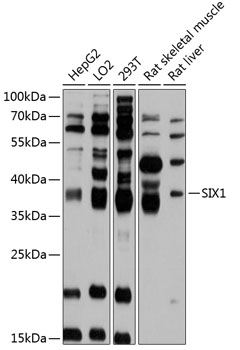Anti-SIX1 Antibody (CAB11954)
- SKU:
- CAB11954
- Product type:
- Antibody
- Reactivity:
- Human
- Reactivity:
- Rat
- Host Species:
- Rabbit
- Isotype:
- IgG
- Antibody Type:
- Polyclonal Antibody
- Research Area:
- Cell Death
Description
| 抗体名: | Anti-SIX1 Antibody |
| 抗体コード: | CAB11954 |
| 抗体サイズ: | 20uL, 50uL, 100uL |
| 申し込み: | WB |
| 反応性: | Human, Rat |
| 宿主種: | Rabbit |
| 免疫原: | Recombinant fusion protein containing a sequence corresponding to amino acids 60-270 of human SIX1 (NP_005973.1). |
| 申し込み: | WB |
| 推奨希釈: | WB 1:500 - 1:2000 |
| 反応性: | Human, Rat |
| ポジティブサンプル: | HepG2, LO2, 293T, Rat skeletal muscle, Rat liver |
| 免疫原: | Recombinant fusion protein containing a sequence corresponding to amino acids 60-270 of human SIX1 (NP_005973.1). |
| 精製方法: | Affinity purification |
| ストレージバッファ: | Store at -20'C. Avoid freeze / thaw cycles. Buffer: PBS with 0.02% sodium azide, 50% glycerol, pH7.3. |
| アイソタイプ: | IgG |
| 順序: | RGNF RELY KILE SHQF SPHN HPKL QQLW LKAH YVEA EKLR GRPL GAVG KYRV RRKF PLPR TIWD GEET SYCF KEKS RGVL REWY AHNP YPSP REKR ELAE ATGL TTTQ VSNW FKNR RQRD RAAE AKER ENTE NNNS SSNK QNQL SPLE GGKP LMSS SEEE FSPP QSPD QNSV LLLQ GNMG HARS SNYS LPGL TASQ PSHG LQTH QHQL QDS |
| 遺伝子ID: | 6495 |
| Uniprot: | Q15475 |
| セルラーロケーション: | Cytoplasm, Nucleus |
| 計算された分子量: | 32kDa |
| 観察された分子量: | 38kDa |
| 同義語: | SIX1, BOS3, DFNA23, TIP39 |
| バックグラウンド: | The protein encoded by this gene is a homeobox protein that is similar to the Drosophila 'sine oculis' gene product. This gene is found in a cluster of related genes on chromosome 14 and is thought to be involved in limb development. Defects in this gene are a cause of autosomal dominant deafness type 23 (DFNA23) and branchiootic syndrome type 3 (BOS3). |
| UniProt Protein Function: | SIX1: May be involved in limb tendon and ligament development. Defects in SIX1 are the cause of deafness autosomal dominant type 23 (DFNA23). A form of non-syndromic deafness characterized by prelingual, bilateral, symmetric hearing loss with a conductive component present in some but not all patients. Defects in SIX1 are the cause of branchiootic syndrome type 3 (BOS3). BOS3 is a syndrome characterized by usually bilateral branchial cleft fistulas or cysts, sensorineural and/or conductive hearing loss, pre-auricular pits, and structural defects of the outer, middle or inner ear. Otic defects include malformed and hypoplastic pinnae, a narrowed external ear canal, bulbous internal auditory canal, stapes fixation, malformed and hypoplastic cochlea. Branchial and otic anomalies are as those seen in individuals with the branchiootorenal syndrome. However, renal anomalies are absent in branchiootic syndrome patients. Defects in SIX1 could be a cause of branchiootorenal syndrome (BOR). BOR is an autosomal dominant disorder manifested by various combinations of preauricular pits, branchial fistulae or cysts, lacrimal duct stenosis, hearing loss, structural defects of the outer, middle, or inner ear, and renal dysplasia. Associated defects include asthenic habitus, long narrow facies, constricted palate, deep overbite, and myopia. Hearing loss may be due to mondini type cochlear defect and stapes fixation. Penetrance of BOR syndrome is high, although expressivity can be extremely variable. Belongs to the SIX/Sine oculis homeobox family. |
| UniProt Protein Details: | Protein type:Cell development/differentiation; DNA-binding; Transcription factor Chromosomal Location of Human Ortholog: 14q23.1 Cellular Component: nucleolus; nucleus; transcription factor complex Molecular Function:DNA binding; protein binding; sequence-specific DNA binding; transcription factor activity Biological Process: embryonic cranial skeleton morphogenesis; embryonic skeletal morphogenesis; epithelial cell differentiation; generation of neurons; induction of an organ; inner ear development; inner ear morphogenesis; kidney development; myoblast migration; negative regulation of neuron apoptosis; pattern specification process; positive regulation of transcription from RNA polymerase II promoter; positive regulation of transcription, DNA-dependent; regulation of neuron differentiation; regulation of transcription, DNA-dependent; skeletal muscle development; thymus development; thyroid gland development; ureteric bud branching; ureteric bud development Disease: Branchiootic Syndrome 3; Branchiootorenal Syndrome 1; Deafness, Autosomal Dominant 23 |
| NCBI Summary: | The protein encoded by this gene is a homeobox protein that is similar to the Drosophila 'sine oculis' gene product. This gene is found in a cluster of related genes on chromosome 14 and is thought to be involved in limb development. Defects in this gene are a cause of autosomal dominant deafness type 23 (DFNA23) and branchiootic syndrome type 3 (BOS3). [provided by RefSeq, Jul 2008] |
| UniProt Code: | Q15475 |
| NCBI GenInfo Identifier: | 2495290 |
| NCBI Gene ID: | 6495 |
| NCBI Accession: | Q15475.1 |
| UniProt Secondary Accession: | Q15475,Q53Y16, Q96H64, |
| UniProt Related Accession: | Q15475 |
| Molecular Weight: | 32kDa |
| NCBI Full Name: | Homeobox protein SIX1 |
| NCBI Synonym Full Names: | SIX homeobox 1 |
| NCBI Official Symbol: | SIX1 |
| NCBI Official Synonym Symbols: | BOS3; TIP39; DFNA23 |
| NCBI Protein Information: | homeobox protein SIX1 |
| UniProt Protein Name: | Homeobox protein SIX1 |
| UniProt Synonym Protein Names: | Sine oculis homeobox homolog 1 |
| Protein Family: | Homeobox protein |
| UniProt Gene Name: | SIX1 |


